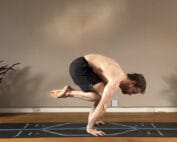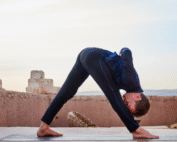
Bakasana (Crane Pose): “How to do Bakasana and progress from Basic to Advanced?
I’m Dav Jones, your yoga teacher and trainer. In this blog, we’ll dive into the world of Bakasana (Crane Pose). We’ll cover its benefits, the key muscles worked, essential preparatory poses, detailed step-by-step instructions, useful modifications, and the potential risks associated with this pose. Join me as we explore how to safely and effectively master Bakasana, enhancing your yoga practice. Let’s get started!
What is Bakasana?
Bakasana, also known as Crane Pose, is a posture of the arm-balance family in yoga. This pose helps build strength in your arms and core while improving balance and focus. It’s a great way to challenge yourself and add variety to your yoga practice.
The meaning of “Bakasana” in Sanskrit
“Bakasana” comes from the Sanskrit words “Baka” (meaning “crane”) and “Asana” (meaning “pose”). The name reflects the shape of your body in this pose, resembling a crane standing tall and steady. It’s the ideal balance of power and elegance.
Preparatory Poses for Bakasana Pose
Before attempting Bakasana (Crane Pose), it’s essential to prepare your body with specific poses that build strength, flexibility, and balance. These preparatory poses help warm up the necessary muscles and joints, reducing the risk of injury and increasing your chances of mastery.

Warming up the wrists in preparation for Bakasana is vital. Spend up-to 15 minutes warming the wrists before practising Bakasana.

Strengthens the arms, shoulders, and core, providing a solid foundation for Bakasana.

Tiger Curls are often practiced by starting in Downward Dog raising one leg into Downdog Split and bringing the knee forward and tapping the arm above the elbow, extend the leg back to Downdog Split. Repeat this repetitively 4/5 times.
How do you do Bakasana? (Crane Pose)
Level: Intermediate
Bakasana (Crane Pose) is an advanced arm balance that builds strength, balance, and confidence. It is more challenging than Crow Pose and requires considerable strength to maintain the posture with confidence and poise. This pose primarily focuses on strengthening the arms, shoulders, and core while improving balance and coordination.
Steps to Perform Bakasana
1. Start in a Squat (Malasana)
Position: Begin by squatting down with your feet slightly wider than your hips. See if you can bring your heels to the mat. If your heels don’t touch the ground, you can place a folded blanket or towel under them for support.
Keep your knees wide and your torso upright. Press your elbows against the inside of your knees to open your hips and bring your palms together in front of your chest.

2. Place Your Hands on the Floor
- Position: Lean forward and place your hands on the floor about shoulder-width apart. Place your hands forward of your feet and aim to fully straighten the arms.
- Ensure that your fingers are pointing forward and your palms are flat on the ground. Grip the mat firmly as if you’re trying to create a fist with your hands.
- Try to place your knees as close up into the armpits as you can.

3.Lift Your Hips and Lean Forward
- Position: Begin to lean forward into your fingertips feeling the weight lighten in the feet. Continue to lean forward with the dominance of weight being felt in the hands and arms.
- Lift one foot first, and then slowly with almost all weight in the hands now lift the second foot.
- Keep your gaze forward to help with balance.

4. Lift Single Foot and Pull Heels to Buttocks
- Action: to make the hips feel lighter, actively draw your heels towards your buttocks.
- Maintain a slight rounding in your upper back and continue to push through the arms spreading the shoulder blades in your upper back.
5. Crane Pose (Bakasana)
- Aim to hold Crane Pose for 5 full breaths.

Don’t Do This Pose If
- Wrist injuries: The pressure on the wrists can exacerbate these conditions.
- Shoulder Issues: This pose can strain the shoulders, so avoid it if you have any shoulder injuries.
- High Blood Pressure: The inversion aspect of Bakasana may not be suitable for individuals with high blood pressure.
- Pregnancy: The balancing and core engagement required in this pose can be risky during pregnancy.
Always listen to your body, and avoid pushing through pain or discomfort. If you’re unsure about practising Bakasana due to any health concerns, consult with a healthcare professional or a certified yoga instructor.
Benefits of Bakasana (Crane Pose)
- Strengthens Arms and Wrists: Builds muscle and endurance in arms, wrists, hips and legs.
- Tones Core Muscles: Strongly contracts Rectus Abdominals.
- Improves Balance and Coordination: Enhances overall stability and coordination.
- Boosts Confidence: Successfully holding the pose increases self-confidence.
Modifications and Variations of Bakasana Pose
Understanding the modifications and variations of Bakasana (Crane Pose) is essential for practitioners at all levels. These adjustments can help you safely progress towards Crane Pose, accommodate your current skill level, and challenge yourself appropriately.
Modifications for Beginners
1.Using a Block
- Place a yoga block under your feet to give you a bit of elevation. This can make it easier to lift off the ground and find your balance.

2. Supine Bakasana
- Mimic the shape of Bakasana on your back. This is a great way to work on strengthening your abdominals and takes out the added difficulty of the arm-balance.
- Hold this shape for 5 breaths, X 3 sets

3. Practice Lolasana Holds
- Lolasana is a posture where the legs are placed in between the arms and you aim to lift the legs and feet off the floor. This posture looks very similar to Crane Pose with the only difference being that the legs are not in contact with the arms.
- Try Knee Lifts, Single Leg lift, and both Leg Lifts.



Variations for Advanced Practitioners
1.Eka Pada Bakasana (One-Legged Crane Pose)
- Extend one leg straight back while keeping the other knee on your upper arm. This variation adds a challenge to your balance and core strength.
2.Parsva Bakasana (Side Crane Pose)
- Twist your torso to one side and balance with both knees on one upper arm. This variation enhances your oblique strength and improves flexibility.
3.Jump Back to Chaturanga
- From Bakasana, jump your feet back into Chaturanga Dandasana. This advanced transition requires strong core and arm strength and fluid movement.
Anatomy and The Muscles Activated in Crane Pose
Understanding the anatomy involved in Bakasana (Crane Pose) is crucial for practising it safely and effectively. Knowing which muscles to engage and how to align your body properly can help prevent injuries and maximise the benefits of this powerful arm balance. Here’s a simple breakdown:
Key Muscles Engaged:
- Shoulders and Upper Arms:
Serratus Anterior – Concentrically (shortened) contracted.
Biceps – Eccentrically (lengthened) contracted.
Triceps – Concentrically (shortened) contracted.
Anterior Deltoids – Concentrically (shortened) contracted. - Lower Arms (forearms):
Extensor Forearm group – Concentrically (shortened) contracted.
Flexors Forearm group – Eccentrically (lengthened) contracted. - Abdominal Muscles:
Rectus Abdominis – Concentrically (shortened) contracted.
Internal Abdominal Obliques – Concentrically (shortened) contracted.
External Abdominal Obliques – Concentrically (shortened) contracted.
Transversus Abdominis – Concentrically (shortened) contracted. - Hands & Fingers: The Muscles in the palm of your hands are in an eccentrically lengthened position with the fingers in a gripping action to provide stability and balance.
- Legs & Hip Flexors:
Psoas Major Muscle (Hip Flexor) – Concentrically (shortened) contracted.
Hamstrings Muscle Group – Concentrically (shortened) contracted.
Gastrocnemius (Calf muscle) – Concentrically (shortened) contracted. - Ankles & Feet:
Plantar Fascia – Concentrically (shortened) contracted.
Anterior Foot (top) Muscles – Eccentrically (lengthened) contracted.
Anatomical Joint Functions:
- Hands: Place hands shoulder-width apart, fingers spread, gripping and pressing firmly into the ground.
- Wrists: Extended
- Elbows: Extended
- Spine: Flexion
- Hips: Flexion
- Knees: Flexion
- Ankles: Plantar Flexed.
Final Thought
In this blog, we’ve explored the basics of Bakasana (Crane Pose), including its benefits, the muscles worked, preparatory poses, step-by-step instructions, modifications, and the potential risks. For a deeper understanding and personalised guidance, enquire about the Dav Jones Yoga Mentorship program
To further advance your practice, visit the Dav Jones Yoga Patreon channel where I teach comprehensive yoga classes tailored to your needs. Let’s continue this journey together towards mastering Bakasana and beyond.









